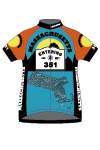In May 2025, Mike is crisscrossing Western Pennsylvania, visiting the most "extracted" countryside in America: starting with the beaver trade that provoked the French and Indian War, through the coal mines, oil wells and gas fracking of today. He is using the effort to raise money for cancer research at Dana-Farber as a supplement to his regular Pan-Mass Challenge (PMC) fundraising. Donations, large and small, are welcomed and can be made via this link.
8 days and 550 miles of riding, taking in the sights and the history along the way.
Pittsburgh - Steel City! Hometown of my partner Sarah. The beloved football team, the "Stillers" (trust me, that's how it sounds). My exploration of Western PA had to start with an exploration of steel and the people who have produced steel (and before that, iron) for over 150 years.
Pittsburgh became "Steel City" because of its unique location - close to the Appalachian coal sources to provide coke and energy, close to the limestone quarried in Ohio, and due to the rivers and railroad network, an easy destination for iron ore. Great rail and river distribution opportunities for finished product. The banks along the Monongahela River (locally referred to as "the Mon") were lined with blast furnaces. The Mon Valley became "Steel Valley".
Pittsburgh also became a magnet for the last important raw material - labor, lots of it. Beyond the mills, the Mon was lined with shantytowns - filled with immigrant labor, predominantly Eastern European during the 1880-1940 period. My prep reading, Out of This Furnace, written by a third-generation immigrant based on his family's experience, documented how life in the mills was incredibly hard and dangerous. Workers were required to work twelve-hour shifts, seven days a week at a pay of 15 cents an hour (and yes, 15 cents went further in 1890 than today, but it was still a subsistence wage). The "Hunkies" (a catchall for Eastern European laborers, drawn from Hungarian) were viewed as interchangeable and disposable. The cycle of poverty was reinforced when children reaching 12 or 13 were drawn into work to help support the family. Deaths and disability were endemic.
Andrew Carnegie, the leading steelmaker, cultivated a philanthropic image. But when faced with a strike at Homestead Works to end the 84 hour work weeks, he brought in Pinkerton guards and ultimately the state militia to break the strike - including shooting down several union strikers. However, in compensation, Carnegie built a library for Homestead. Thanks Andrew!
We had the opportunity to tour one of US Steel's former operations, the Carrie Blast Furnace, shuttered in 1982. The National Park Service took charge of preserving Carrie as an historical site and an affiliated non-profit provides tours. Our tour guide had worked both at Carrie and at Homestead across the river (closed in 1978), and was able to bring the operation to life. The photos don't really do justice to the scale of the place - the two remaining blast furnaces and their associated "stoves" (which feed superheated gas into the blast furnace) are over 100 feet high, on top of a structure that is about as tall. The guide took a lot of questions, including being asked what he thought about the pending acquisition of US Steel by Nippon Steel of Japan. "My initial reaction was 'no way the Japanese should be allowed to buy US Steel'. But after hearing how many billions they are planning to invest, how they are planning on keeping the US Steel name and consolidating their existing US operations into the company and keeping headquarters in Pittsburgh, it feels a lot better than status quo". We also learned about the origin of "Pittsburgh Rare" steak - the workers would bring steaks to work, and for lunch would pop them on the 1000 degree pipe to the blast furnace, searing them 30 seconds on a side, raw in the middle.
I'm taking a second tour on the Mon later this week; today I turned up its tributary, the Youghiogheny (aka "the Yough" - rhymes with Rock). The Yough never had the heavy industry of the Mon, but riding along the Great Allegheny Passage rail trail you see abandoned industrial operations, coal piles, signs pointing to long-gone mines. Sarah's mother Meg grew up in West Newton, a Yough River town. Meg was orphaned at 15 when a freight train derailed and crashed through her father's grocery store, killing him. Sarah grew up visiting West Newton regularly with her mother but hadn't been there for years. I left her to visit the family plot and finished the day's efforts.
I will say, the towns I passed through were well kept and felt alive in a way that the towns I saw in the Mississippi and Arkansas Deltas did not. I spent 45 minutes waiting out a rainstorm in Perryopolis, a town of 2,000 that traces its origins back to George Washington's investment in a grain mill. Perryopolis has had a stable population since 2000 - not thriving, but not dying. Gas fracking (a topic I will also explore in more depth on a later journey) has helped put some money back into the local coffers. Because I spent so much time on the GAP today, I didn't get my usual dose of "meeting normal people". Another opportunity to do that tomorrow!
Hot Metal Bridge - Southside Pittsburgh
Homestead Works -- all that's left
Hunkies still in Homestead
USS's Edgar Thompson Works - Braddock
Great Allegheny Passage trail
Last climb of the day -- Laurel Highlands await!

